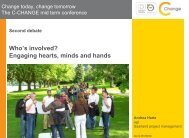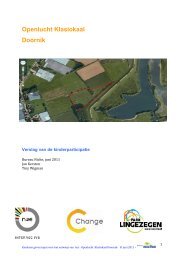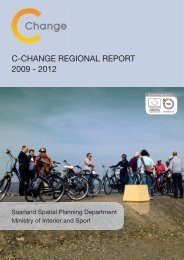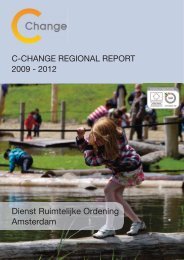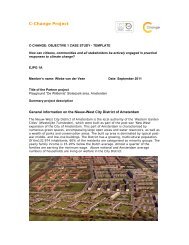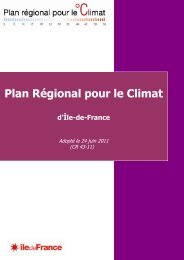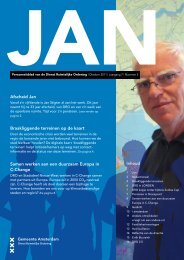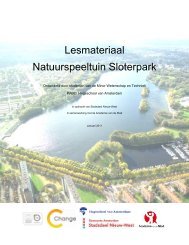Amsterdam 2040
Amsterdam 2040
Amsterdam 2040
- No tags were found...
Create successful ePaper yourself
Turn your PDF publications into a flip-book with our unique Google optimized e-Paper software.
Quality, time and moneyKeimpe Reitsma <strong>Amsterdam</strong> Development Corporation(Ontwikkelingsbedrijf <strong>Amsterdam</strong>, or OBA)The Structural Vision is first of all about ambitions andopening up broad panoramas. It goes without saying thatquality is of paramount importance, but at a given momentthe execution comes up for discussion, the matter of makingchoices. That is also a necessity, because the new SpatialPlanning Act (Wet ruimtelijke ordening, Wro) prescribes thatin the Structural Vision the municipalities must also indicatehow they expect to effect the policy’s implementation. That isa fine passage, which you could dwell upon for a long time,certainly the phrase ‘to effect implementation’. The questionis how you can bring about that materialization on the basisof your spatial ambitions. And for that we have found asimple but actually quite brilliant formula: it was decided to setout the realization of the Structural Vision along a timeline. Byopting for a phased realization in three consecutive decades,time has become the flexible factor and the ambitions andthe final outcome have been preserved intact. The motto isthat if it doesn’t materialize today, then it will tomorrow.isie<strong>2040</strong>When the financial crisis raised its head, it happened upona Structural Vision in the throes of development. What doesthis crisis mean for the Structural Vision? Relatively little inthe light of the above, but it did become obvious that theambitions for developing new housing over the first decadewere too high. Shifting the construction of 10,000 dwellingsfurther along the timeline resulted in the painting a more balancedpicture of the future without it affecting <strong>Amsterdam</strong>’sambition to realize 70,000 new dwellings. This was madepossible by the chosen arrangement by decade.But what about that other factor, the money, and doesn’tthat throw a spanner in the works? Something that becameincreasingly apparent during the drafting of the StructuralVision was that less money would be available for urbanprojects than in former times. Important sources of revenue,such as the sale of land for office developments and statesupport for housing construction, have dried up. Sometimesit seems as if there are no longer any funds whatsoever fornew projects, but this ignores the most important financialmainstay of urban developments: the ‘big-money’ demandfor more city. And for the time being that demand shall notbe drying up.ch sterkamThere will be a demand for more <strong>Amsterdam</strong> and more thanbefore this will have to generate the means to continuebuilding on <strong>Amsterdam</strong>. Capitalizing on that demand willtherefore be an important objective of new site-specificdevelopments. A passage such as ‘to implement’ then fallsinto place. You can then also deduce that the StructuralVision incorporates the necessary leeway, for which the fillingin will only become obvious in the long run. Those who arenot reassured by all of this might derive comfort from thewords of the Nobel laureate Ivo Andric: ‘The most terribleand most tragic of all human weaknesses is undoubtedly hiscomplete inability to see into the future, which stands in sharpcontrast with his many talents, his knowledge and his art.’Haarlem to <strong>Amsterdam</strong>and backMarc Hanou Project Manager, Structural Vision forNorth HollandFrom a legal perspective the earlier structural plans for<strong>Amsterdam</strong> were regional plans, for which <strong>Amsterdam</strong> hadreceived the mandate known as ‘freedom in policy’ from theProvince of North Holland. But that was in the days of the‘old’ Spatial Planning Act. In 2000, the City of <strong>Amsterdam</strong>and the Province of North Holland took the initiative toestablish a platform for the North Wing of the Randstad(Noordvleugel), with the aim of devising a shared vision forthe future in cooperation with the 30 or so municipalitiesacross the region. For the region it was an unprecedentedmodel of ‘governance’, though I wonder whether we knewwhat such a collaboration was called back then.In 2007, even before the introduction of the ‘new’ SpatialPlanning Act, a decision was taken to formulate theDevelopment Scenario for the North Wing of the Randstadin <strong>2040</strong> (Ontwikkelingsbeeld Noordvleugel <strong>2040</strong>), which wasmeant to serve as the point of departure for the formulationof all the structural visions in the <strong>Amsterdam</strong> MetropolitanArea. This Development Scenario was a vision for the futurewhich had been forged by means of an open, participativeand intensive collaboration among the government bodiesconcerned. Immediately after the ratification of this vision,the Province of North Holland began work on its StructuralVision. The preceding collaboration was well received,and had whet the appetite for more, so all North Holland’smunicipalities were invited – the City of <strong>Amsterdam</strong> and the<strong>Amsterdam</strong> City Region platform in particular – to participatein the ‘Structural Vision for North Holland’ project as fullmembers of the team.The involvement of <strong>Amsterdam</strong>’s Department of PhysicalPlanning and the City Region platform in the project team forthe Province of North Holland’s structural vision establisheda collaboration that fostered mutual trust and involved thesharing of content as well as weekly or even daily interchanges:different dishes were prepared using the sameingredients in everyone’s respective kitchens. This was aunique situation that produced two structural visions, eachof which does justice to the formulated point of departure inits own way, elaborating the essential points from the NorthWing Development Scenario for <strong>2040</strong> – the growth andprosperity of the metropolis, the city centre densification,measures for dealing with the changing climate, tacklingextra- and intra-regional accessibility and the use of themetropolitan landscapes – in different ways. Locally wherepossible and centrally where necessary, but always foundedon mutual trust and reciprocal effort.01 | 2011 25




